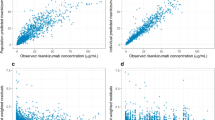Abstract
Objective: The aim of the present study was to investigate the pharmacokinetics and pharmacodynamics of low-dose methotrexate (MTX) in the early phase (3 months) after the start of antipsoriatic therapy.
Methods: Ten male and female psoriatic patients who failed to respond to previous conventional therapy were treated with 15 mg oral MTX once per week. The pharmacokinetics in plasma and the urinary excretion of MTX and 7-hydroxymethotrexate (7-OH MTX) were investigated after doses 1, 5 and 13 (corresponding to phases I, II and III, respectively). On the same occasions, MTX accumulation in erythrocytes obtained before MTX administration was investigated. Pharmacodynamics of MTX were evaluated using the psoriasis area and severity index (PASI) score.
Results: There were marked intersubject differences (range of coefficients of variation 34.9–76.3%) in the area under the curve (AUC), peak concentration (Cmax) and clearance (CL) of MTX. Total CL was proportional to renal clearance (CLR) (r 2 = 0.735, P < 0.0001) which accounted for 73 (19)% of the former. There was a strong linear relationship (r 2 = 0.819, P < 0.0001) between CL of MTX and creatinine clearance. Within 48 h of drug administration, the urinary excretion of MTX was 46–99% of the dose, while that of 7-OH MTX was 1.5–8.6%. In 8 of 10 patients, more than 70% of the MTX dose was recovered. No intraindividual variations of MTX kinetic parameters during treatment were observed. MTX concentrations in erythrocytes reached the steady-state concentration in the range 40.7–170 nmol · l−1 after 2 months of therapy. Pharmacodynamic measurement versus pharmacokinetics revealed a significant inverse relationship between PASI score and MTX AUC (r s = −0.912, P < 0.002) and between PASI score and erythrocytic MTX (r s = −0.988, P < 0.002).
Conclusion: The relationship between MTX pharmacokinetics (AUC or erythrocytic MTX) and pharmacodynamics (PASI score) may exist. It is likely that the efficacy of psoriasis therapy with MTX could be improved by adjusting the dose according to plasma concentrations obtained after the first MTX administration.
Similar content being viewed by others
Author information
Authors and Affiliations
Additional information
Received: 15 April 1997 / Accepted in revised form: 18 July 1997
Rights and permissions
About this article
Cite this article
Chládek, J., Martínková, J., Šimková, M. et al. Pharmacokinetics of low doses of methotrexate in patients with psoriasis over the early period of treatment. E J Clin Pharmacol 53, 437–444 (1998). https://doi.org/10.1007/s002280050404
Issue Date:
DOI: https://doi.org/10.1007/s002280050404




